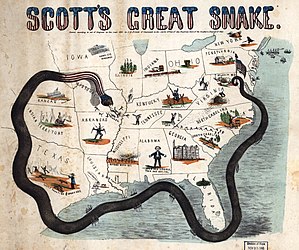
Back Mararmea blokado Esperanto Blocus de l'Union French Blokade Union ID Blocco dell'Unione Italian 北軍による海上封鎖 Japanese Obsidio navalis Belli Civilis Americani Latin Bloqueio da União Portuguese Морская блокада Юга Russian Unionsblockaden Swedish 蟒蛇计划 Chinese
| Union blockade | |||||||
|---|---|---|---|---|---|---|---|
| Part of the American Civil War | |||||||
 Scott's great snake, J.B. Elliot | |||||||
| |||||||
| Belligerents | |||||||
|
|
| ||||||
| Commanders and leaders | |||||||
|
|
| ||||||
The Union blockade in the American Civil War was a naval strategy by the United States to prevent the Confederacy from trading.
The blockade was proclaimed by President Abraham Lincoln in April 1861, and required the monitoring of 3,500 miles (5,600 km) of Atlantic and Gulf coastline, including 12 major ports, notably New Orleans and Mobile. Those blockade runners fast enough to evade the Union Navy could carry only a small fraction of the supplies needed. They were operated largely by British citizens, making use of neutral ports such as Havana, Nassau and Bermuda. The Union commissioned around 500 ships, which destroyed or captured about 1,500 blockade runners over the course of the war.
The blockade was largely successful in reducing 95% of cotton export in the South from pre-war levels, devaluing its currency and severely damaging its economy. However, it was less successful in preventing war material from being smuggled into the South. Throughout the conflict, at least 600,000 arms (mostly British Pattern 1853 Enfield rifles)[1] were smuggled by blockade runners to the Confederacy, 330,000 of them into the Gulf ports.[2] Historians have estimated that supplies brought to the Confederacy via blockade runners that made it past the Union blockade lengthened the duration of the conflict by up to two years.[3][4][5]
- ^ Kevin Dougherty (30 September 2010). Weapons of Mississippi. University Press of Mississippi. p. 87. ISBN 9-7816-0473-4522.
- ^ Daniel O'flaherty (August 1955). "The Blockade That Failed". American Heritage. Vol. 6, no. 5.
- ^ "Alabama Claims, 1862-1872". GlobalSecurity.org.
- ^ David Keys (24 June 2014). "Historians reveal secrets of UK gun-running which lengthened the American civil war by two years". The Independent.
- ^ Paul Hendren (April 1933). "The Confederate Blockade Runners". United States Naval Institute.
© MMXXIII Rich X Search. We shall prevail. All rights reserved. Rich X Search